Event-ready lens kits can transform your smartphone into a versatile photography powerhouse. You'll want to include wide-angle lenses for group shots, macro lenses for intricate details, and telephoto lenses for distant subjects. Don't forget fisheye lenses for creative perspectives and various filters to manage lighting conditions. Verify your kit has compatible mounting systems and a protective carrying case. Regular cleaning and maintenance will keep your lenses in top shape. With the right preparation and equipment, you'll be ready to capture any event like a pro. Discover how each component can elevate your mobile photography game.
Essential Mobile Lens Kit Components
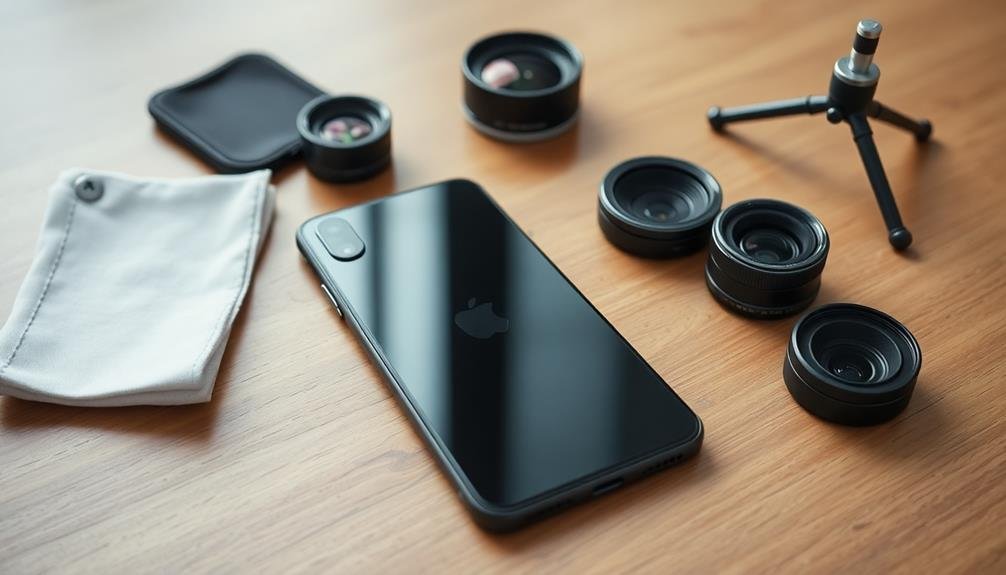
In addition to your smartphone's built-in camera, a well-rounded mobile lens kit should include several key components.
First, you'll want a wide-angle lens to capture expansive scenes and group shots. This lens widens your phone's field of view, allowing you to fit more into the frame.
Next, consider a macro lens for close-up shots of small details. It's perfect for capturing intricate textures, flowers, or miniature subjects.
A telephoto lens is vital for zooming in on distant subjects without losing image quality. It's ideal for wildlife photography or capturing performances from afar.
Don't forget a fisheye lens for creative, distorted perspectives. This ultra-wide-angle lens produces a distinctive curved effect, great for artistic shots or capturing tight spaces.
Include lens clips or cases to securely attach these lenses to your phone. A microfiber cloth is essential for keeping your lenses clean and smudge-free.
Finally, invest in a compact tripod or stabilizer to guarantee steady shots, especially in low-light conditions or when using slower shutter speeds.
With these components, you'll be ready to tackle any event photography challenge.
Wide-Angle Lenses for Group Shots
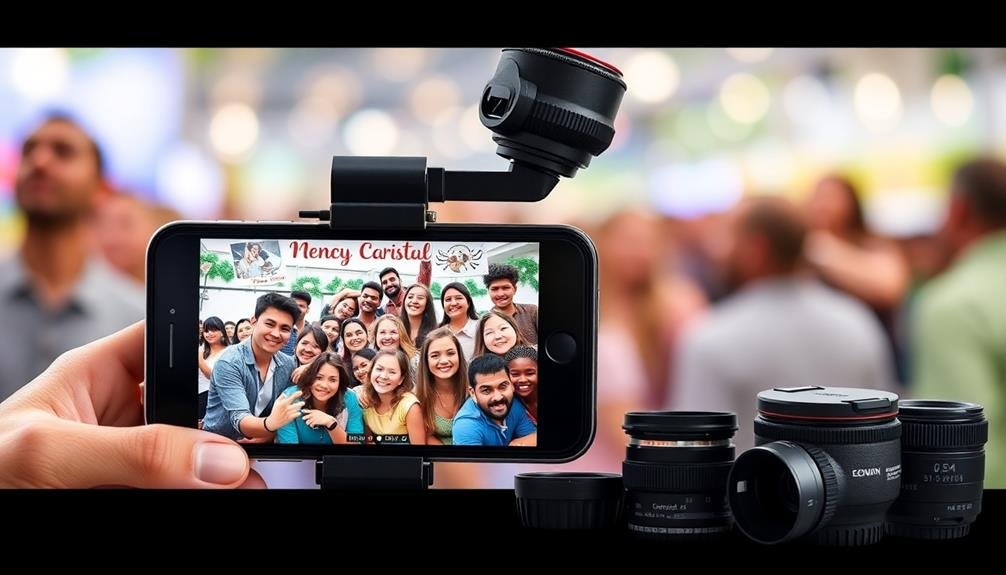
Wide-angle lenses are a group-shot game-changer for mobile photographers. They expand your phone camera's field of view, allowing you to capture more people and scenery in a single frame. When you're shooting large groups or in tight spaces, these lenses become indispensable.
Most wide-angle lenses for smartphones offer a 120-degree to 140-degree field of view. This broader perspective lets you fit more subjects into your shot without having to back up excessively. You'll find it easier to photograph large families, wedding parties, or conference attendees in one go.
When selecting a wide-angle lens, look for ones with minimal distortion. While some distortion is inevitable, high-quality lenses minimize the "fisheye" effect that can warp faces at the edges of your images.
Consider lenses with anti-glare coatings to reduce lens flare in bright conditions.
Remember that wide-angle lenses work best when you're close to your subjects. Don't be afraid to get near the group you're photographing. This proximity will help maintain detail and sharpness across the entire frame, ensuring everyone in your group shot looks their best.
Macro Lenses for Detail Captures
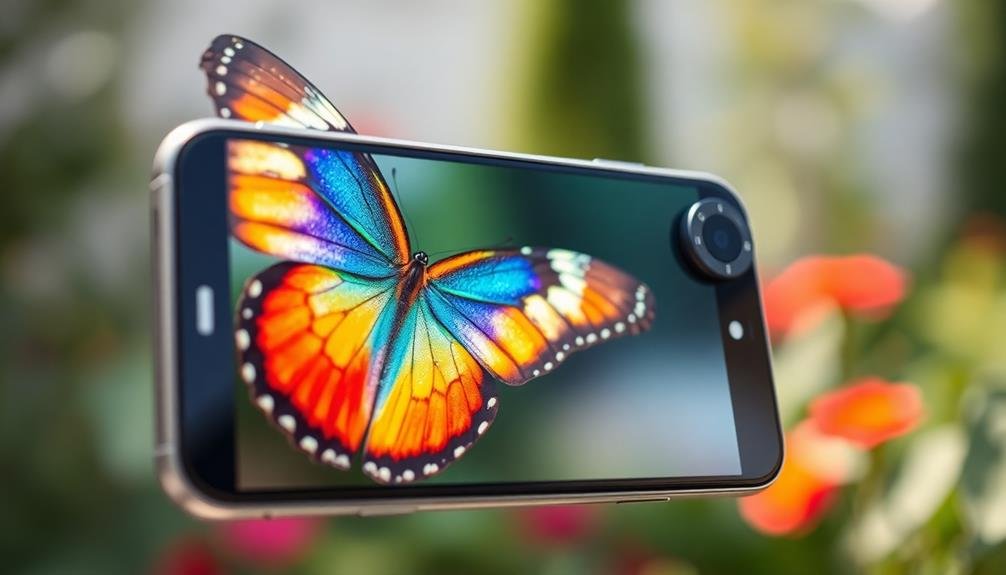
Expand your event photography capabilities with a macro lens for stunning detail shots.
You'll capture the intricate beauty of flowers, zoom in on tiny insects for enchanting portraits, and reveal hidden textures and patterns in everyday objects.
These close-up shots add depth and variety to your event coverage, offering guests a unique perspective on the small wonders surrounding them.
Close-Up Flower Photography
When it comes to capturing the intricate details of flowers, macro lenses are your best friends. These specialized lenses allow you to get incredibly close to your subject, revealing the delicate textures, vibrant colors, and hidden structures of even the tiniest blooms.
With a macro lens attached to your smartphone, you'll be able to transform ordinary flowers into extraordinary works of art.
To make the most of your close-up flower photography, follow these tips:
- Choose flowers with interesting patterns or textures
- Use natural light whenever possible for soft, even illumination
- Experiment with different angles to find unique perspectives
- Focus on specific parts of the flower, like stamens or petals
Don't be afraid to get creative with your compositions. Try capturing water droplets on petals or showcasing the contrast between a flower and its surroundings.
Remember to keep your camera steady to guarantee sharp images, as even the slightest movement can blur your shot when working at such close range.
With practice and patience, you'll soon be producing stunning macro images that showcase the beauty of flowers in ways you've never seen before.
Tiny Insect Portraits
From the minute world of insects emerges an enchanting area of photography waiting to be explored. With the right macro lens attachment for your smartphone, you'll reveal a sphere of tiny details invisible to the naked eye.
These specialized lenses allow you to capture intricate textures, vibrant colors, and fascinating structures of insects up close.
When choosing a macro lens for insect photography, look for options with high magnification ratios, typically 10x or higher. You'll want a lens that can focus on subjects as close as 0.5 inches away.
Some macro lenses come with built-in LED lights, which are invaluable for illuminating your tiny subjects without casting harsh shadows.
To capture stunning insect portraits, stability is essential. Use a mini tripod or stabilizing grip to minimize camera shake.
Patience is key—insects move quickly, so you'll need to wait for the perfect moment. Focus on the insect's eyes to create an enchanting image.
Experiment with different angles and backgrounds to add depth and context to your shots. With practice, you'll soon be creating mesmerizing portraits of the insect world that reveal nature's hidden artistry.
Texture and Pattern Exploration
A world of intricate textures and mesmerizing patterns awaits your smartphone's macro lens. With this powerful tool in your event-ready kit, you'll capture stunning close-ups that reveal hidden details invisible to the naked eye. From the delicate veins of a leaf to the intricate weave of fabric, macro photography opens up a whole new dimension of visual storytelling.
To make the most of your macro lens, focus on subjects with interesting textures or repeating patterns. You'll be amazed at how ordinary objects transform into abstract art when viewed up close. Here are some ideas to get you started:
- Rough tree bark or smooth pebbles
- Colorful flower petals or geometric tile work
- Rusty metal surfaces or shimmering water droplets
- Feathers, scales, or insect wings
When shooting macro, pay attention to lighting. Soft, diffused light often works best to highlight textures without harsh shadows.
Don't be afraid to experiment with different angles and compositions. Sometimes, the most enthralling shots come from unexpected perspectives. Remember to keep your hand steady or use a small tripod for sharp results, as even tiny movements can blur your image at such close range.
Telephoto Lenses for Distant Subjects
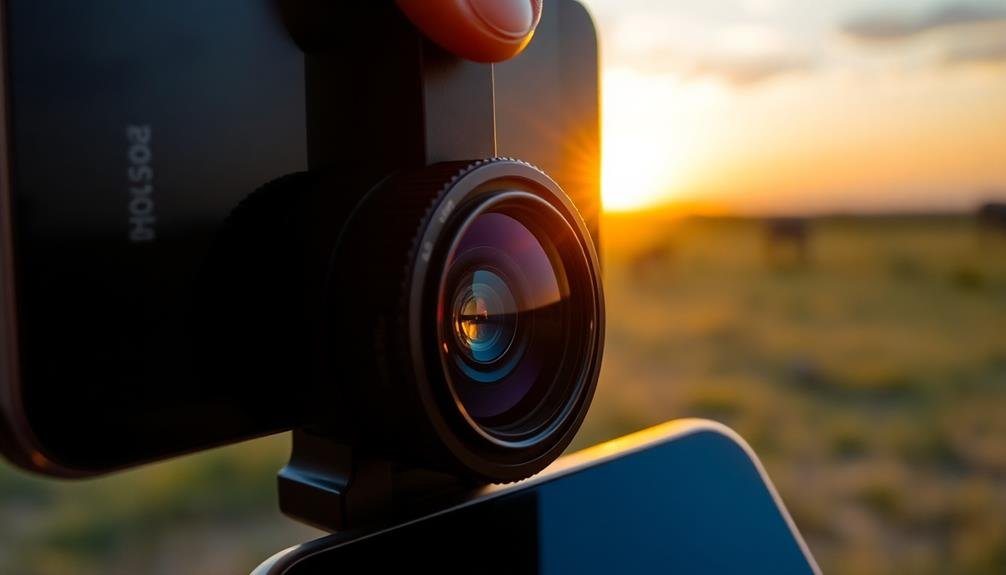
Telephoto lenses are the long-range snipers of event photography. They'll help you capture distant subjects with clarity and detail, making them essential for large venues or outdoor events. You'll be able to zoom in on speakers on stage, athletes on the field, or performers from the back of the crowd.
Most clip-on telephoto lenses for smartphones offer 2x to 3x optical zoom, which can greatly extend your reach. Some high-end options even provide up to 10x zoom. When choosing a telephoto lens, consider the magnification level, image quality, and compatibility with your phone model.
Remember that telephoto lenses compress the perspective, making objects appear closer together than they actually are. This effect can create interesting compositions and flatten backgrounds. However, it also means you'll need to be more aware of camera shake. Use a smartphone tripod or stabilizer to guarantee sharp images, especially in low light conditions.
While telephoto lenses excel at bringing distant subjects closer, they're not ideal for wide-angle shots or close-ups. Always pack a standard lens alongside your telephoto to maintain versatility in your event photography kit.
Fisheye Lenses for Creative Perspectives
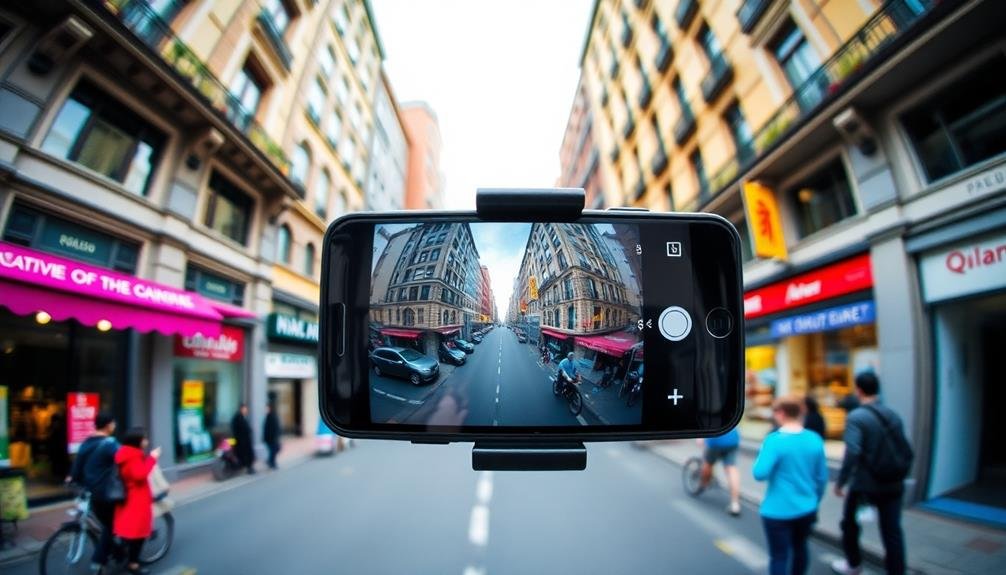
While standard and telephoto lenses capture scenes as we typically perceive them, fisheye lenses offer a unique and creative perspective for event photography. These ultra-wide-angle lenses produce a distinctive curved, spherical effect that can add drama and intrigue to your shots.
You'll find fisheye lenses particularly useful for capturing expansive spaces or creating surreal, distorted images that stand out from conventional event photos.
When using a fisheye lens, you'll want to get close to your subjects to maximize the lens's effect. This proximity allows you to create immersive, all-encompassing images that draw viewers into the scene.
Fisheye lenses are especially effective for:
- Capturing large group shots in tight spaces
- Emphasizing the energy of dance floors or crowded venues
- Creating dynamic architectural images of event spaces
- Adding a playful, whimsical touch to portraits
Remember that fisheye lenses require some practice to master. Experiment with different angles and compositions to find the most compelling results.
While they may not be suitable for every shot, including a fisheye lens in your event kit can provide you with a powerful tool for creating memorable, eye-catching images that set your work apart.
Anamorphic Lenses for Cinematic Looks
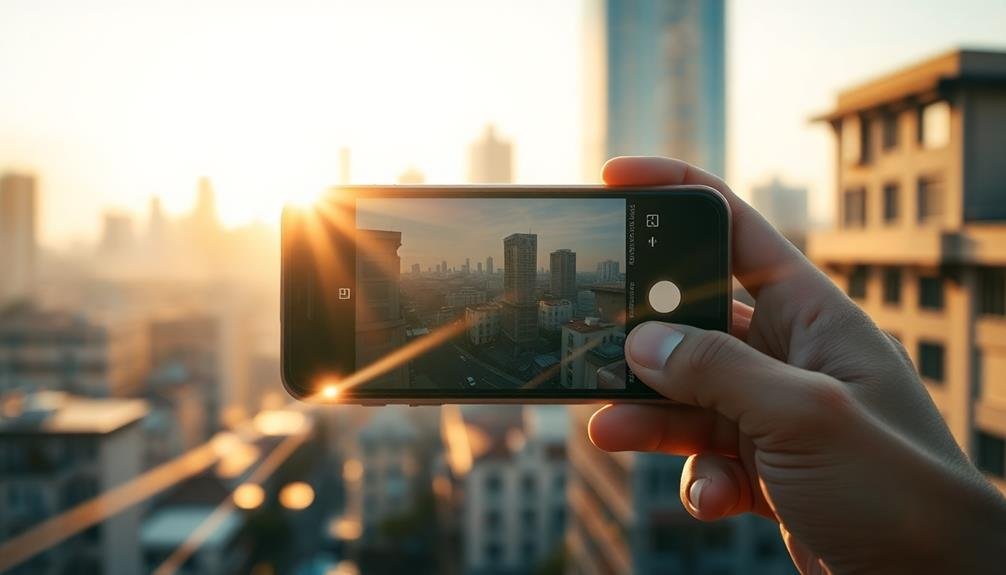
Anamorphic lenses can transform your event footage into a cinematic masterpiece.
You'll capture a wider field of view with the distinctive widescreen aspect ratio that's synonymous with Hollywood productions.
These lenses also produce unique, horizontal lens flares that add a touch of drama and visual interest to your shots.
Widescreen Aspect Ratio Effects
Cinematic allure often comes from the distinctive widescreen look that's become synonymous with big-budget films. With anamorphic lenses, you can achieve this effect in your mobile photography. These specialized lenses compress a wider field of view horizontally, allowing you to capture more of the scene without sacrificing image quality.
When you shoot with an anamorphic lens, you'll need to de-squeeze your footage in post-processing to achieve the widescreen aspect ratio. This process expands the image horizontally, resulting in the characteristic 2.39:1 or 2.35:1 aspect ratio.
The widescreen format offers several advantages:
- Improved compositional possibilities
- Enhanced sense of scale and grandeur
- More immersive viewing experience
- Ability to capture expansive landscapes or large group shots
Besides the aspect ratio, anamorphic lenses produce unique visual characteristics. You'll notice oval bokeh, horizontal lens flares, and a slight distortion at the edges of the frame.
These effects contribute to the cinematic feel of your images and videos. By incorporating anamorphic lenses into your mobile lens kit, you'll have the tools to create Hollywood-style visuals for your events, giving your work a professional edge.
Unique Lens Flare Characteristics
Lens flares are a hallmark of anamorphic cinematography, and they're unlike anything you'll see with standard spherical lenses. When you use an anamorphic lens attachment for your smartphone, you'll notice distinctive horizontal flares that stretch across the frame.
These flares appear as blue streaks when bright light sources hit the lens at certain angles. The unique flare characteristics come from the lens's oval-shaped elements and special coatings.
You'll find that these flares add a cinematic quality to your footage, reminiscent of big-budget films. They're particularly effective in low-light situations or when shooting backlit subjects.
To maximize the effect, try positioning your light sources just out of frame. This technique will create dramatic flares without overwhelming your image.
You can also experiment with different angles to control the intensity and direction of the flares.
Lens Filters for Various Lighting
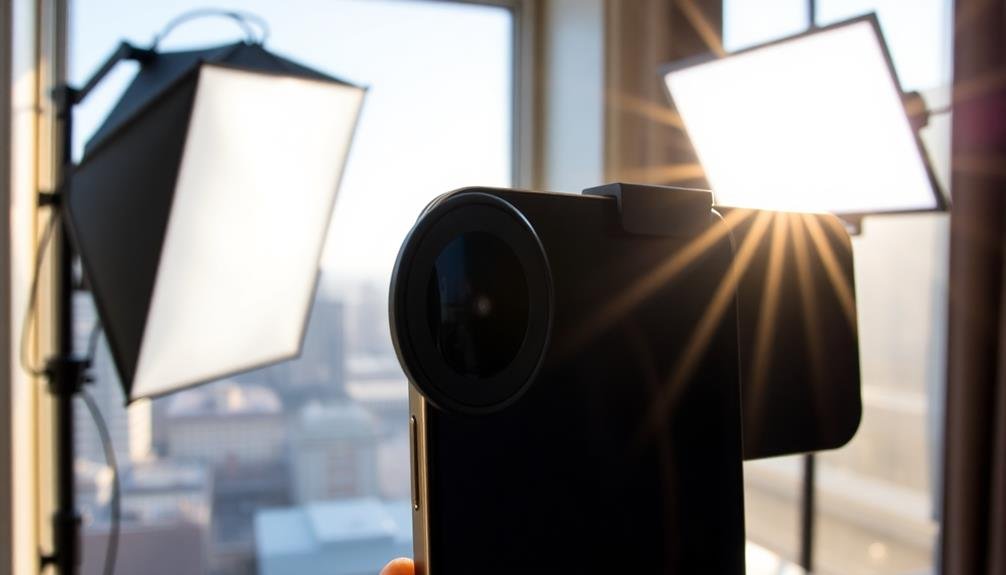
Four essential lens filters can dramatically improve your event photography in various lighting conditions.
These filters help you manage challenging lighting scenarios, enhance colors, and create artistic effects. A polarizing filter reduces glare and reflections, making it ideal for outdoor events or shooting through glass.
It'll also deepen blue skies and increase color saturation. For low-light situations, a UV filter can protect your lens while allowing more light to reach the sensor.
When dealing with harsh sunlight, a neutral density (ND) filter is your best friend. It reduces the amount of light entering the lens, enabling you to use slower shutter speeds or wider apertures for creative effects.
Finally, a color correction filter can help balance the color temperature in mixed lighting environments, ensuring accurate skin tones and overall color fidelity.
To get the most out of your lens filters:
- Always clean them before use
- Stack filters carefully to avoid vignetting
- Practice using filters before important events
- Invest in high-quality filters for better results
Mounting Systems and Compatibility
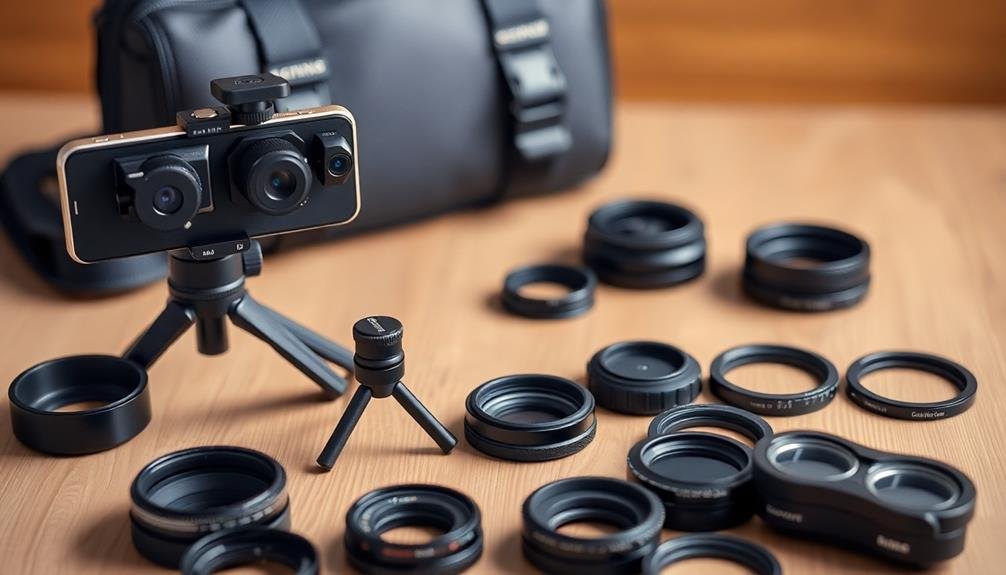
When it comes to lens filters, understanding mounting systems and compatibility is crucial for seamless integration with your camera setup.
You'll encounter two main types of mounting systems: screw-in and square filter systems. Screw-in filters attach directly to your lens's front thread, offering a compact and straightforward solution. Square filter systems use a holder that attaches to your lens, allowing you to slide filters in and out quickly.
To verify compatibility, check your lens's thread size, typically marked on the lens barrel. For square systems, confirm that the holder fits your lens diameter. Some manufacturers offer step-up or step-down rings to adapt filters to different lens sizes.
Consider your shooting style when choosing a system. If you frequently switch filters, a square system might be more convenient. For occasional use or when weight is a concern, screw-in filters are ideal.
Many event photographers opt for a hybrid approach, using screw-in filters for common needs like UV protection and polarization, while keeping a square system on hand for graduated filters or special effects.
This versatility allows you to tackle any lighting situation you might encounter during an event.
Carrying Cases for Lens Protection
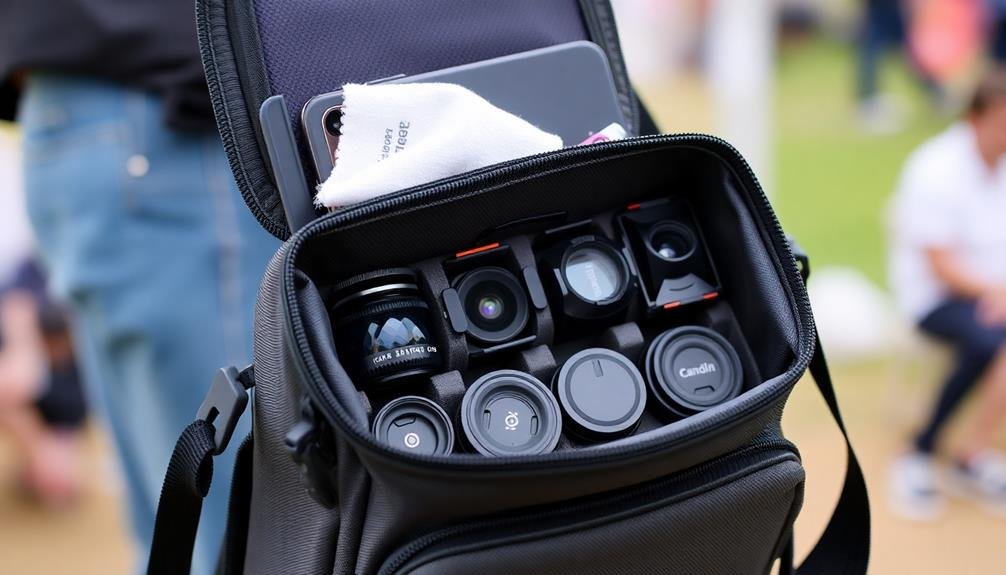
Throughout your event photography career, protecting your valuable lenses is paramount. Carrying cases designed specifically for lens protection are essential components of any event-ready kit. These cases come in various sizes and styles to accommodate different lens collections and shooting needs.
When selecting a carrying case for your lenses, consider the following factors:
- Padding and shock absorption
- Water-resistance or waterproofing
- Customizable compartments
- Ease of access during shoots
Opt for cases with thick, high-density foam inserts that can be customized to fit your specific lenses snugly. This prevents them from shifting during transport and protects against accidental drops.
Look for cases with weather-sealed zippers and durable, water-resistant exteriors to safeguard your gear in unpredictable outdoor conditions.
For events that require quick lens changes, choose a case with easy-access compartments or a top-loading design. This allows you to swap lenses efficiently without fumbling through a cluttered bag.
Some cases even feature belt loops or shoulder straps for hands-free carrying, keeping your lenses within reach while you navigate crowded venues or challenging shooting environments.
Cleaning and Maintenance Tips
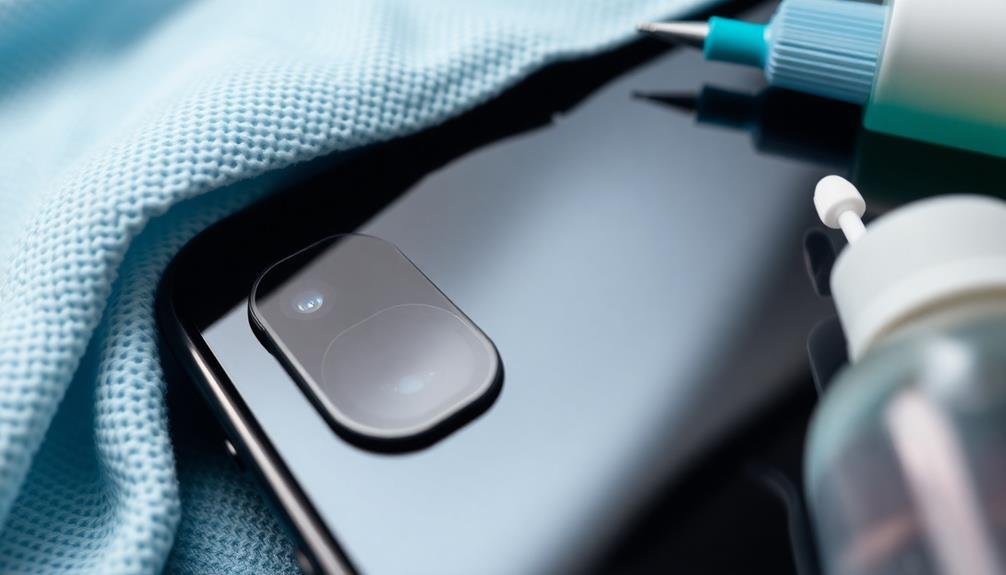
To maintain the pristine condition of your lenses, regular cleaning and proper maintenance are essential.
Start by investing in a microfiber cloth and lens cleaning solution specifically designed for camera optics. Before cleaning, gently blow off any loose dust or debris using a blower or compressed air. Apply a small amount of cleaning solution to the cloth, never directly on the lens. Wipe in a circular motion from the center outward, being careful not to apply too much pressure.
For stubborn smudges, use lens cleaning wipes or pre-moistened tissues. Don't forget to clean the lens mount and contacts with a dry microfiber cloth.
When changing lenses, do so quickly and in a clean environment to minimize dust entering your camera.
Store your lenses in a cool, dry place when not in use. Use silica gel packets in your camera bag to absorb moisture. Regularly check for fungus or haze, especially in humid climates.
If you notice any issues, consult a professional for thorough cleaning or repair. By following these tips, you'll guarantee your lenses remain in top condition, ready for your next mobile photography adventure.
Frequently Asked Questions
How Do Mobile Lens Kits Compare to Dedicated Cameras for Event Photography?
You'll find mobile lens kits more convenient and versatile for event photography. They're lightweight and easily swappable. However, dedicated cameras offer superior image quality, better low-light performance, and more advanced features for professional-level results.
Can I Use Mobile Lens Kits for Professional Event Photography?
You can use mobile lens kits for professional event photography, but they have limitations. They're great for enhancing your phone's capabilities, but won't match the quality and versatility of professional cameras. Consider them as a backup or supplement.
Are There Any Smartphone-Specific Lens Kits for Popular Models?
Yes, you'll find smartphone-specific lens kits for popular models. Brands like Moment, ShiftCam, and Olloclip offer lenses tailored to fit iPhones and top Android devices. They're designed to snap on easily and enhance your phone's camera capabilities.
How Do Mobile Lens Kits Affect Smartphone Battery Life During Events?
Mobile lens kits don't directly impact your phone's battery life. However, you'll likely use your camera more during events, which can drain power faster. Consider carrying a portable charger to keep your device running throughout the day.
Can I Use Mobile Lens Kits for Video Recording at Events?
Yes, you can use mobile lens kits for video recording at events. They'll enhance your smartphone's video capabilities, allowing you to capture wide-angle shots, zoom in on distant subjects, or create unique effects for your event footage.
In Summary
You're now equipped to capture any moment with your mobile lens kit. Remember to experiment with different lenses and filters to find your unique style. Keep your kit clean and protected, and you'll always be ready for that perfect shot. Don't forget to practice with each lens type to master their capabilities. With your event-ready kit, you'll transform your smartphone into a versatile photography tool for any occasion.

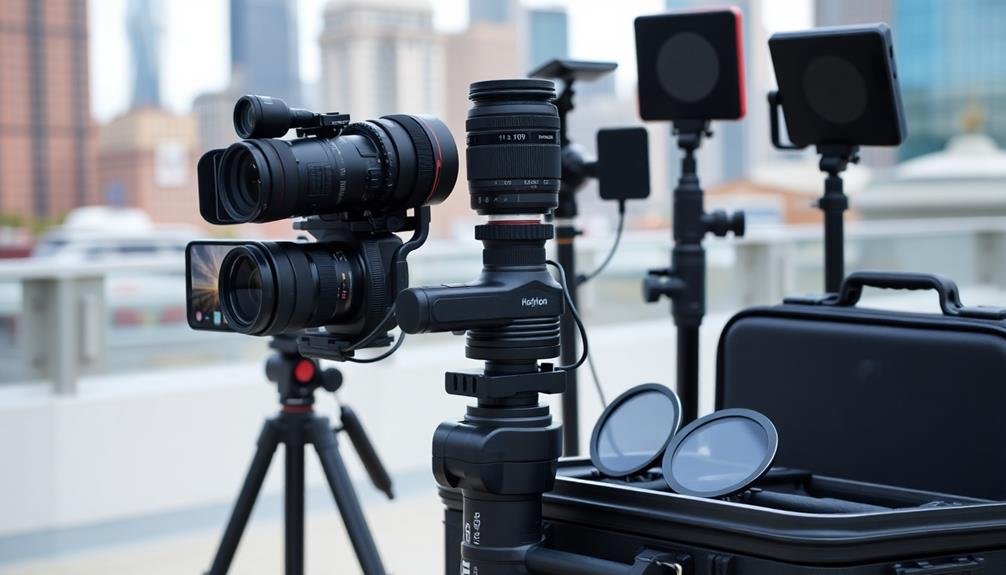



Leave a Reply